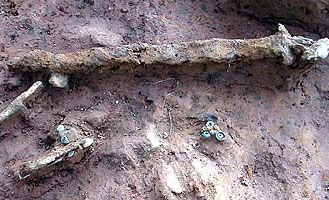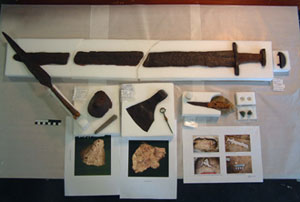Posted: 23 October 2006
National Roads Authority and UCD Archaeologists conserve Viking weaponry find
Some time around 850 an unknown Viking warrior died – possibly in battle. His comrades would have wrapped his body, dug a pit and with due ceremony, broken his weapons before they set him in the ground.
1150 years later, archaeologists commissioned by the NRA (National Roads Authority), working on the N25 routeway in Waterford, discovered the pit and the magnificent collection of iron weapons – but no body. What happened to the Viking warrior’s body remains a mystery which may never be solved.
Found some distance from the main Woodstown site, the block of earth containing the grave was carefully preserved and extracted from the ground. The weapons – a full sword, broken into three pieces but with some of the scabbard attached, a shield boss (the convex piece of material at the centre of the shield designed to deflect blows), a spear head, a wooden handled knife (embedded in stone), a bronze cloak pin and a sharpening stone, provided confirming evidence that the site was of significant importance and helped to date it to within 50 years of the arrival of the first Vikings to Ireland in the 9th century.

Archaeological site
Objects like this - swords in particular - belonged to the prosperous and the powerful in the early Viking Age, in this case one of the 'hersir' - the middle rank of warrior who was probably, back home in Norway, an independent land owner or local chieftain. Swords were objects of remarkable symbolic and ideological power, often handed down through the generations from father to son, and these weapons have clearly been ritually 'killed' or destroyed by the graveside - perhaps upon the burial of a man who was the last in his line.

Viking weaponry find following conservation at UCD School of Archaeology including: a full sword, a shield boss, a spear head, a wooden handled knife, a bronze cloak pin and a sharpening stone
The archaeological dig at Woodstown, which was undertaken by Archaeological Consultancy Services, has unearthed a Viking find of larger proportions than at Wood Quay in Dublin.
According to Fred Barry, Chief Executive of the NRA, the discovery demonstrates the value of good planning. “The Woodstown site is a great example of how planning and development can work positively. The road plan was the catalyst for the initial dig and we where able to accommodate the findings during the planning stage.”
The findings are currently on exhibition at the Waterford Museum of Treasures at The Granary in Waterford. The exhibition will run until the end of November. It was officially opened by Mr Martin Cullen TD, Minister for Transport and by Dr Patrick Wallace, Director of the National Museum of Ireland who is an expert in the Viking period.
The Viking warrior’s grave was just one element of the treasures uncovered. The weapons were sent to the UCD School of Archaeology for conserving and analysis. At the School, conservation specialists Claudia Koehler and Susannah Kelly painstakingly cleaned each item, which had arrived like blobs of rusty metal, using an air abrasive machine to reveal their secrets.
“It’s been perhaps 120 years since a shield boss was unearthed in Ireland and to discover a sword is always special,” says Susannah Kelly. “A full-weaponry find like this is very unusual.” The condition of the weapons tells the conservators something of what happened all those centuries ago. “The corrosion on the breaks in the sword proves that it was broken as part of a ceremony rather than through disturbance of the grave later on. The iron running lengthways along the centre of the sword is narrower – probably to lighten its weight and the handle is quite small so that the warrior could wedge his hand in tight preventing it from slipping in battle,” adds Claudia Koehler – who specialises in Viking artefacts.
UCD School of Archaeology provides a full-support service to professional archaeologists in the field. Conserving uncovered artefacts is just one example of how the university works to support the curation, conservation and analysis of archaeological objects recovered in the remarkable boom in archaeological excavations in Ireland today.
